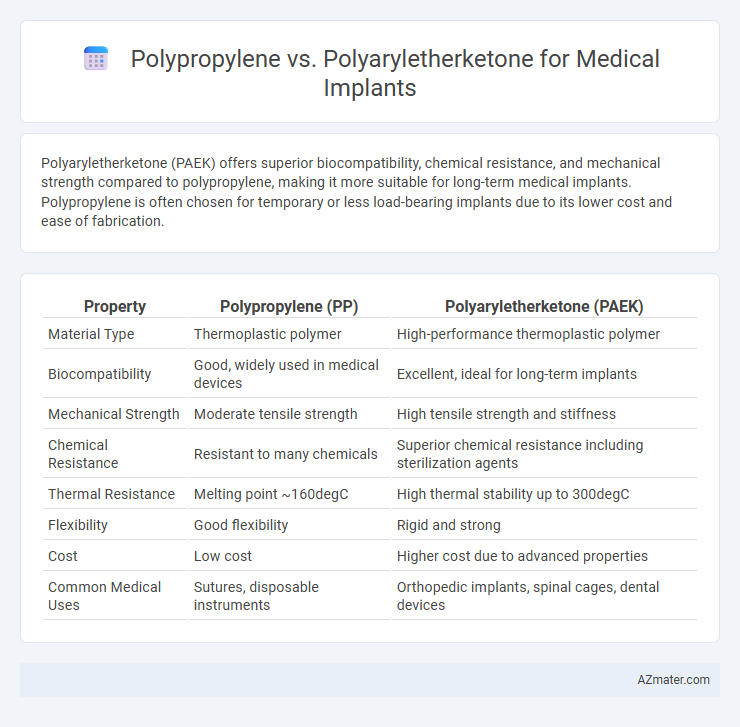Polyaryletherketone (PAEK) offers superior biocompatibility, chemical resistance, and mechanical strength compared to polypropylene, making it more suitable for long-term medical implants. Polypropylene is often chosen for temporary or less load-bearing implants due to its lower cost and ease of fabrication.
Table of Comparison
| Property | Polypropylene (PP) | Polyaryletherketone (PAEK) |
|---|---|---|
| Material Type | Thermoplastic polymer | High-performance thermoplastic polymer |
| Biocompatibility | Good, widely used in medical devices | Excellent, ideal for long-term implants |
| Mechanical Strength | Moderate tensile strength | High tensile strength and stiffness |
| Chemical Resistance | Resistant to many chemicals | Superior chemical resistance including sterilization agents |
| Thermal Resistance | Melting point ~160degC | High thermal stability up to 300degC |
| Flexibility | Good flexibility | Rigid and strong |
| Cost | Low cost | Higher cost due to advanced properties |
| Common Medical Uses | Sutures, disposable instruments | Orthopedic implants, spinal cages, dental devices |
Introduction to Medical Implant Materials
Medical implant materials must exhibit biocompatibility, mechanical strength, and chemical resistance to ensure safety and longevity within the human body. Polypropylene is a widely used polymer in medical implants due to its affordability, ease of processing, and good biocompatibility, but it may lack the high-temperature resistance and long-term durability of advanced materials. Polyaryletherketone (PAEK), including polyetheretherketone (PEEK), offers superior mechanical properties, chemical stability, and radiolucency, making it increasingly favored for demanding orthopedic and spinal implant applications.
Overview of Polypropylene (PP)
Polypropylene (PP) is a thermoplastic polymer widely used in medical implants due to its excellent chemical resistance, biocompatibility, and affordability. Its low density and high tensile strength make it suitable for lightweight, durable medical devices such as sutures, meshes, and components in orthopedic implants. PP's semi-crystalline structure ensures good fatigue resistance and sterilization compatibility, making it a reliable choice compared to more expensive polymers like polyaryletherketone (PAEK).
Overview of Polyaryletherketone (PAEK)
Polyaryletherketone (PAEK) is a high-performance thermoplastic renowned for its exceptional chemical resistance, biocompatibility, and mechanical strength, making it ideal for medical implants. Its inherent sterilizability and resistance to wear enable long-term stability within the human body, surpassing conventional materials like polypropylene in durability and reliability. The polymer's capacity to maintain integrity under physiological conditions ensures its widespread use in orthopedic and dental implant applications.
Mechanical Properties Comparison
Polyaryletherketone (PAEK) exhibits superior mechanical properties compared to polypropylene for medical implants, including higher tensile strength and exceptional fatigue resistance, making it suitable for load-bearing applications. Polypropylene, while offering good flexibility and chemical resistance, lacks the stiffness and thermal stability required for long-term implant durability. PAEK's enhanced mechanical performance ensures sustained functionality under physiological stresses, critical for implant longevity and patient safety.
Biocompatibility and Biological Response
Polyaryletherketone (PAEK) demonstrates superior biocompatibility compared to polypropylene, exhibiting excellent chemical stability and resistance to bodily fluids, which minimizes inflammatory responses and tissue irritation in medical implants. Polypropylene, while cost-effective and widely used, may induce higher levels of fibrous encapsulation and less favorable integration due to its relatively lower bio-inertness. The enhanced biological response of PAEK, including reduced bacterial adhesion and better osseointegration, positions it as a preferred material for long-term implant applications requiring durability and biostability.
Sterilization Compatibility
Polyaryletherketone (PAEK) exhibits superior sterilization compatibility compared to polypropylene (PP), tolerating a wider range of sterilization methods including autoclaving, gamma radiation, and ethylene oxide without significant degradation. Polypropylene's susceptibility to thermal deformation limits its use to low-temperature sterilization techniques such as ethylene oxide or gamma irradiation at controlled doses. PAEK's chemical resistance and mechanical stability under sterilization stresses make it the preferred choice for long-term medical implants requiring repeated or aggressive sterilization cycles.
Long-term Performance and Durability
Polyaryletherketone (PEEK) outperforms polypropylene in long-term medical implant applications due to its exceptional chemical resistance, superior mechanical strength, and thermal stability, ensuring durability under physiological conditions. PEEK's biocompatibility and resistance to hydrolysis and sterilization processes prevent material degradation over extended implantation periods, which is critical for maintaining implant integrity. Polypropylene, while cost-effective and flexible, tends to suffer from hydrolytic degradation and mechanical fatigue, limiting its reliability in long-term implant scenarios.
Applications in Medical Implants
Polypropylene is widely used in medical implants such as sutures, hernia repair meshes, and catheter components due to its biocompatibility, chemical resistance, and flexibility. Polyaryletherketone (PAEK), including PEEK, excels in load-bearing implants like spinal cages, dental implants, and orthopedic devices because of its superior mechanical strength, radiolucency, and resistance to sterilization processes. Both polymers meet stringent medical standards, but PAEK's enhanced durability and high-temperature stability make it preferable for long-term, high-stress implant applications.
Cost and Manufacturing Considerations
Polypropylene offers significantly lower material and processing costs compared to polyaryletherketone (PAEK), making it a more economical choice for medical implant manufacturing. PAEK requires advanced machining or injection molding techniques due to its high melting point and chemical resistance, resulting in longer production cycles and increased fabrication expenses. Cost efficiency in polypropylene is balanced against PAEK's superior mechanical properties and biocompatibility, which may justify higher manufacturing investments for specialized implant applications.
Future Trends in Implant Material Development
Polyaryletherketone (PAEK) is gaining preference over polypropylene in medical implants due to its superior biocompatibility, mechanical strength, and chemical resistance, which support long-term implant stability. Future trends emphasize the integration of bioactive coatings and enhanced additive manufacturing techniques to tailor PAEK implants for personalized patient needs. Research is also advancing toward incorporating antimicrobial properties and promoting tissue regeneration to improve implant success rates.

Infographic: Polypropylene vs Polyaryletherketone for Medical Implant
 azmater.com
azmater.com